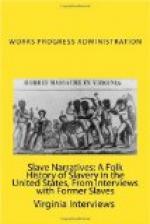“Once before de wah, I was ridin Lazy, my donkey, a few miles from de boss’ place at Fairview, when along came a dozen or more patrollers. Dey questioned me and decided I was a runaway slave and dey wuz gwine to give me a coat of tar and feathers when de boss rode up and ordered my release. He told dem dreaded white patrollers dat I was a freeman and a ’parson’.”
When the slaves were made free, some of the overseers tooted horns, calling the blacks from their toil in the fields. They were told they need no longer work for their masters unless they so desired. Most of the darkeys quit “den and dar” and made a quick departure to other parts, but some remained and to this day their descendants are still to be found working on the original plantations, but of course for pay.
Describing the clothing worn in summer time by the slaves, he said they mostly went barefooted. The men and boys wore homespun, three-quarter striped pants and sometimes a large funnel-shaped straw hat. Some wore only a shirt as a covering for their body.
“In winter oxhide shoes were worn, much too large, and the soles contained several layers of paper. We called them ‘program’ shoes, because the paper used for stuffing, consisted of discarded programs. We gathered herbs from which we made medicine, snake root and sassafras bark being a great remedy for many ailments.”
Williams, though himself not a slave by virtue of the fact that his grandmother was an Indian, was considered a good judge of healthy slaves, those who would prove profitable to their owners, so he often accompanied slave purchasers to the Baltimore slave markets.
He told of having been taken by a certain slave master to the Baltimore wharf, boarded a boat and after the slave dealer and the captain negotiated a deal, he, Williams, not realizing that he was being used as a decoy, led a group of some thirty or forty blacks, men, women and children, through a dark and dirty tunnel for a distance of several blocks to a slave market pen, where they were placed on the auction block.
He was told to sort of pacify the black women who set up a wail when they were separated from their husbands and children. It was a pitiful sight to see them, half naked, some whipped into submission, cast into slave pens surrounded by iron bars. A good healthy negro man from 18 to 30 would bring from $200 to $800. Women would bring about half the price of the men. Often when the women parted with their children and loved ones, they would never see them again.
Such conditions as existed in the Baltimore slave markets, which were considered the most important in the country, and the subsequent ill treatment of the unfortunates, hastened the war between the states.
The increasing numbers of free negroes also had much to do with causing the civil war. The South was finding black slavery a sort of white elephant. Everywhere the question was what to do with the freeman. Nobody wanted them. Some states declared they were a public nuisance.




